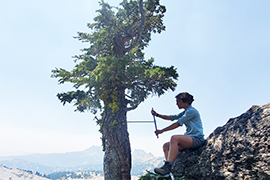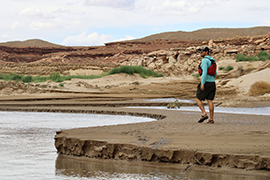EDS: This is a partner story from KUNC. If you choose to use it, please fill out this form to help their tracking.
- Slug: BC-CNS-Tree Tales,530 words.
- 2 photos, audio story available (thumbnails, captions below)
By Alex Hager
KUNC
The current Western megadrought is unlike any other dry period the region has experienced over the past 500 years.
That’s according to a new study in which scientists looked at tree rings to track changing temperatures going back to 1553. Researchers found that human-fueled climate change is driving temperatures higher, which makes soil drier and droughts more frequent, intense and widespread.
Karen King, an assistant professor at the University of Tennessee-Knoxville and the study’s lead author, said it shows the role of temperature in shaping modern drought.
“We know that extreme heat has consequences,” King said. “We know that drought has consequences. So when they’re compounded together, we can expect that those vulnerabilities are only going to be magnified and the consequences are going to be more wide reaching.”
The study, which was published in the journal “Science Advances,” analyzed cross-sections of trees from a number of Western states, including Utah, New Mexico and Wyoming. The study’s authors concluded that the two-decade period from 2000 to 2020 was the warmest in half a millennium.
The consequences of dry conditions in the 21st century include significant strain on the Southwest’s most important water supply, the Colorado River, which supplies about 40 million people across seven states. It has been shrinking as a result of those higher temperatures, but demand for water has not.
Policymakers around the region have struggled to rein in demand for water, even as more than two decades of dry conditions have shrunk the nation’s two largest reservoirs – Lake Mead and Lake Powell, both on the Colorado River – to record lows.
Some scientists and water managers say the Southwest’s currently dry period extends beyond the normal definition of “drought,” arguing that it should be categorized instead as “aridification,” a permanent resetting of the baseline for how much water enters the region’s streams, rivers and reservoirs each year.
Experts say warm temperatures are, essentially, the first domino in a chain of changing conditions that impact water supply.
Since 2000, average temperatures in the upper Colorado River basin have been more than 2 degrees Fahrenheit warmer than in the previous century. That upper Colorado is the region where the river begins, mostly as snow in high-altitude portions of Colorado and Wyoming.
The new tree-ring study shows how high temperatures have made the region’s soil drier. Dry soil means less water in streams and rivers.
When rain falls or snow melts, it seeps into the dirt before entering streams and rivers. When that dirt is saturated, it can’t absorb additional water, and snowmelt flows directly into nearby waterways. But when the soil is dry, as it is now, it acts like a sponge, soaking up water before it has a chance to reach the places where humans collect it.
The data in this new tree-ring study, as well as findings from other similar research, spell trouble for decision-makers trying to share a shrinking resource across a region with growing populations and a multibillion-dollar agricultural economy.
“While the future of precipitation in the region remains uncertain, projections of increasing temperatures pose substantial risk for intensifying drought conditions and increasing water insecurity for these economically important, population-dense, and historically active megadrought regions,” the study’s authors wrote.
This story is part of ongoing coverage of the Colorado River, produced by KUNC in Colorado and supported by the Walton Family Foundation. KUNC is solely responsible for its editorial coverage.
-This story is part of ongoing coverage of the Colorado River, produced by KUNC and supported by the Walton Family Foundation.
For more stories from Cronkite News, visit cronkitenews.azpbs.org.
^__=
Web links:
_ Study: https://www.science.org/doi/10.1126/sciadv.adj4289
_ River strain: https://www.kunc.org/2021-07-07/after-decades-of-warming-and-drying-the-colorado-river-struggles-to-water-the-west
_ Record lows: https://www.kunc.org/news/2023-02-15/lake-powell-drops-to-a-new-record-low-as-feds-scramble-to-prop-it-up
_ Aridification: https://www.kunc.org/environment/2018-03-28/when-a-drought-lasts-18-years-does-it-need-a-new-name
_ Changing conditions: https://www.kunc.org/environment/2021-11-24/these-four-metrics-are-used-to-track-drought-and-they-paint-a-bleak-picture
_ Soil absorption: https://www.kunc.org/environment/2021-03-31/when-water-is-scarce-some-researchers-go-underground-to-find-out-why
^__=
Karen King, an assistant professor at the University of Tennessee-Knoxville, gathers a core sample from a mountain hemlock tree at Lassen National Volcanic Park in northern California. King is the lead author on a study of tree rings that puts the 21st century Western megadrought into historical context. (Photo by Grant Harley/University Of Idaho)
Eric Balken, executive director of Glen Canyon Institute, walks along a sandbar that had long been submerged under Lake Powell. But as the reservoir drops to record lows, as a result of more than 20 years of drought in the region, areas that were underwater for decades have begun to emerge. (Photo by Alex Hager/KUNC)

